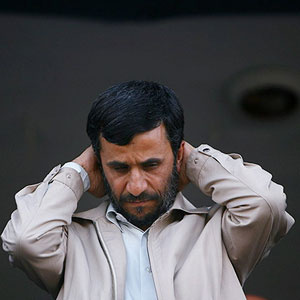A House of Sand and Fog

If in 2005, Ahmadinejad was an unheard-of candidate many voted to because of his youth and obscurity, the 2009 version Iranian president is quite known for everyone. That explains why he found fervent opponents and polarized the Iranian into pro- and anti-Ahmadinejads.
After the numerous dismissals, resignations and reshufflings in the ninth administration, deemed as ordinary changes by Ahmadinejad, it was quite predictable that selection of the tenth cabinet would not end until the legal deadline and would bring up many questions.
Even the most ardent opponents of Ahmadinejad, those whose head is supposed to be ’banged to the ceiling’ as the president has stated, do not want the tenth administration to be an inefficient, problem-causing one with figures who lower the prestige of ministry and weaken Ahmadinejad’s authority.
Expectedly, Ahmadinejad purged his team and proposed candidates whose names no one can pronounce. One reminds Amir Ghalenoyee, famous Iranian soccer coach, who in times of defeat only keeps saying: "do not criticize anyone. I’m the one guilty for this defeat and I personally accept the responsibility for everything." In the first glance, such a remark appears as a sacrifice to bear others’ faults; however, looking closely, we find out that it just implies that the team has a trifling role. No more can the act be appraised called sacrificed.
Frequently it has been said that the tenth presidential election was the springboard of the campaign aimed at transforming power structures in the Islamic Republic and giving birth to a new Islamic regime. Sine qua nons of the transformation process are rejecting former structures and planning a new future. Mahmoud Ahmadinejad definitely knows how to fulfill the first condition. He has been criticizing the history of Islamic Republic since 2005 and holding the delete key since 2009. Nevertheless, both Ahmadinejad and his fellow masterminds lack the ability to actualize the second essential. Neither the Iranian presidential nor his team has been able to plan and actualize strategies of an administration which is supposed to pave the way for the messianic Shiite rule.
The cabinet Ahmadinejad introduced a few days ago and stood behind it ’like a mountain’, is the epitome of inexperience and sets out a new wave of inefficiency and indecision, what Ahmadinejad’s supporters tend to call ’rejuvenation’. But is that the real rejuvenation? No. Rejuvenation means transfusing a new blood into the veins of the government. It equals efficiency and creativity, but what we see of the new cabinet is inexperience and successive mistakes. Juvenility indeed, not rejuvenation.
Ahmadinejad corroborated the notion that he does not favor powerful, thinker –read independent- ministers. He worked with such ministers in his former cabinet and appreciated the problems. The Iranian president is fully aware that repeating the same mistake in selection of his new cabinet means losing control over the ministries and an end to his characteristic unilateralism.
Ahmadinejad’s mentality may be the necessity of the new radical, revolutionary system aimed to be set up from 2009. The tenth administration is weak and detrimental and Ahmadinejad’s arguments in defense of his choices were so mawkish that can not be relied on.
The social and political origins of Ahmadinejad necessitate a new revolutionary generation to come on stage. This renaissance should start from ideals and functionaries of the regime before the society and its culture. Clashing with economic corruption and aristocratism originates from the mentality that has constantly criticized the Reconstruction Administration of Hashemi Rafsanjani, the Reform Administration of Khatami and their adoption of quasi-liberal policies. Ousting the remnant executives of these administrations and insinuating organizations and institutions believed to be supported by Hashemi Rafsanjani are the inevitable outcomes of this mentality.
Rather than change, this approach resembles destruction and obliteration. Furthermore, the changes inside the ninth administration and the interminable comes and goes of ministers and executives imply indecision and inefficiency rather than convergence. Yet it is clear that these dismissals and ’surgeries’ aim to achieve transmutation. Obviously at the current point deconstruction is the number one priority, not efficiency.
On the other hand, introducing three women for ministries –even if they fail to obtain parliament’s vote of confidence - means that no more figures are left in Ahmadinejad’s circle of trust. Ahmadinejad’s populist tendencies and his sentimentality defense have raised concern even among conservatives. Political observers are also concerned about an inexperienced, probably submissive cabinet.
Since Ahmadinejad is the one who moderates the cabinet and appointments and dismissals are in his own hands, it is predictable that the tenth administration will undergo a series of trials and errors. These are definitely the prices which should be paid for structural changes aimed to oust former political parties from power and show a new face of Islamic Republic both inside and outside Iran.
With introduction of the tenth cabinet, a new face of Iran has also been introduced. Passing the turbulent months after the presidential election, with heavy prices paid and ample opportunities missed, Iran will move into a new era in which radical, idealist revolutionaries will seize power to undo all the errors and deviations of revolution. They will also breed a new generation of young, radical and revolutionary executives who will be the next power-holders in the Islamic establishment.
Ministers of the tenth administration are the first managerial products of the ninth government. They share two factors both regarded as valued principles for the tenth cabinet: submission and categorical rejection of past. The ministers contemplate what they say and what they do, since one step out of the given path means falling out of Ahmadinejad’s team.

